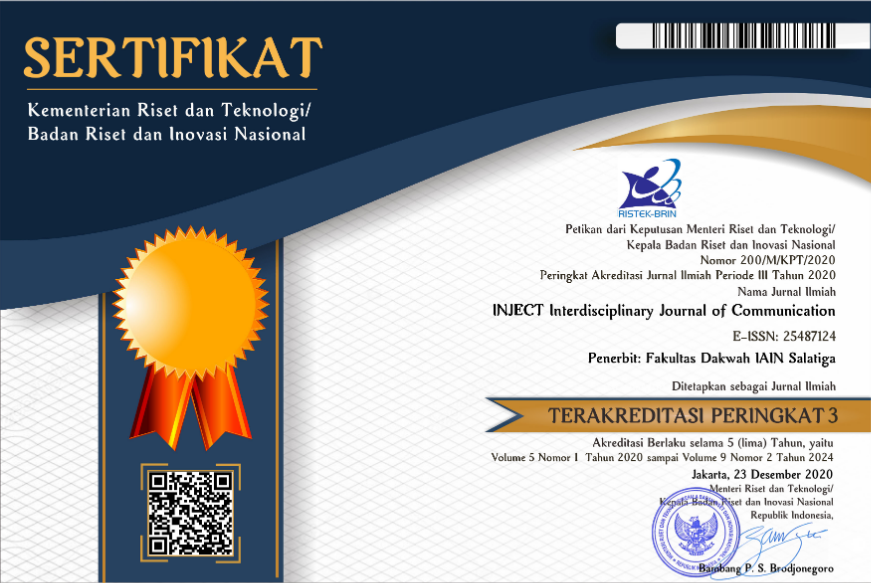“Mirror of Identity”; Political Personalization of French Presidential Candidates in Mass Media
Abstract
English
The development of political communication has brought various interactional communicative strategies among political participants, namely: politicians, journalists and the public. This strategy mainly emerged during the presidential campaign, due to at this time the presidential candidates are competing to win votes. One of the ways to obtain high votes is through political personalization. This identification process is carried out with the help of mass media, which framed the individuality actions of the presidential candidates in various ways. This study analyzes French media framing toward political personalization by Emmanuel Macron (EM) and Marine Le Pen (MLP). Data collection was carried out with the help of NVIVO’s linguistic tools to see trend in lexical forms and lingual expressions used by the media and social media. This research is expected to become a discourse analysis research model based on the interactional system between participants in French politics, particularly those related to national identity.
Keywords
Full Text:
PDFReferences
Aubel, F. (2017, May 9). Emmanuel Macron, un jeune homme si parfait, vraiment ? Retrieved October 7, 2020, from LEFIGARO website: https://www.lefigaro.fr/livres/2017/05/09/03005-20170509ARTFIG00137-emmanuel-macron-un-jeune-homme-si-parfait-vraiment.php
Bean, C., & Mughan, A. (1989). Leadership Effects in Parliamentary Elections in Australia and Britain. American Political Science Review, 83(4), 1165–1179. https://doi.org/10.2307/1961663
Bennett, W. L. (2012). The Personalization of Politics: Political Identity, Social Media, and Changing Patterns of Participation. The ANNALS of the American Academy of Political and Social Science, 644(1), 20–39. https://doi.org/10.1177/0002716212451428
Bennett, W. L., & Pfetsch, B. (2018). Rethinking Political Communication in a Time of Disrupted Public Spheres. Journal of Communication, 68(2), 243–253. https://doi.org/10.1093/joc/jqx017
Bocquet, B. (2018). Le populisme du Front national de Marine Le Pen: Continuités et changements dans le discours frontiste (Master Thesis, Faculté des sciences économiques, sociales, politiques et de communication, Université catholique de Louvain). Faculté des sciences économiques, sociales, politiques et de communication, Université catholique de Louvain, Ottignies-Louvain-la-Neuve. Retrieved from http://hdl.handle.net/2078.1/thesis:14359
Carr, C. T., & Hayes, R. A. (2015). Social Media: Defining, Developing, and Divining. Atlantic Journal of Communication, 23(1), 46–65. https://doi.org/10.1080/15456870.2015.972282
Dalton, R. J., & Wattenberg, M. P. (2002). Parties without partisans: Political change in advanced industrial democracies. Oxford; New York: Oxford University Press.
Durand, A. (2017, May 25). A-t-on raison de chercher en Macron le Trudeau français ? Retrieved September 28, 2020, from Contrepoints website: https://www.contrepoints.org/2017/05/25/290277-a-t-on-raison-de-chercher-macron-trudeau-francais
Galy-Ramounot, M. (2017, April 20). Elles ont 20 ans, pourquoi elles votent Marine Le Pen. Retrieved September 28, 2020, from Madame Figaro website: https://madame.lefigaro.fr/societe/interview-filles-jeunes-20-ans-votent-marine-le-pen-front-national-presidentielle-2017-180417-130988
Garzia, D. (2011). The personalization of politics in Western democracies: Causes and consequences on leader–follower relationships. The Leadership Quarterly, 22(4), 697–709.
Gbadegesin, V. O., & Onanuga, P. A. (2019). The enactment of ideology and self-presentation in political campaign videos of the 2015 general election in Nigeria. Discourse, Context & Media, 28, 121–130. https://doi.org/10.1016/j.dcm.2018.11.002
Grand, S., & Segaunes. (2016, November 16). Ni de droite, ni de gauche: Emmanuel Macron, candidat du troisième type. Retrieved September 30, 2020, from L’Opinion website: https://www.lopinion.fr/edition/politique/emmanuel-macron-candidat-troisieme-type-114505
Han, C. (2015). How to Do Critical Discourse Analysis: A Multimodal Introduction. Australian Journal of Linguistics, 35(4), 415–418. https://doi.org/10.1080/07268602.2015.1033673
Helaoua, Y. (2018, April 23). Emmanuel Macron vu par les Américains: Nouveau Kennedy ou « Mr Nobody » ? Retrieved October 1, 2020, from Ouest-France.fr website: https://www.ouest-france.fr/politique/emmanuel-macron/emmanuel-macron-vu-par-les-americains-nouveau-kennedy-ou-mr-nobody-5715209
Holtz-Bacha, C., Langer, A. I., & Merkle, S. (2014). The personalization of politics in comparative perspective: Campaign coverage in Germany and the United Kingdom. European Journal of Communication, 29(2), 153–170. https://doi.org/10.1177/0267323113516727
Karvonen, L. (2010). The Personalisation of Politics: A Study of Parliamentary Democracies (Reprint edition). Colchester: ECPR Press.
Kern, R. (2015). Multimodal discourse. In Language, Literacy, and Technology (pp. 193–212). Cambridge: Cambridge University Press. https://doi.org/10.1017/CBO9781139567701.010
Le Gal, T. (2017, April 25). Le mot «patriote» au cœur du débat entre Emmanuel Macron et Marine Le Pen. Retrieved October 3, 2020, from 20minute website: https://www.20minutes.fr/elections/presidentielle/2056471-20170425-mot-patriote-ur-debat-entre-emmanuel-macron-marine-pen
McAllister, I. (1996). Leaders. In L. LeDuc, R. G. Niemi, & P. Norris (Eds.), Comparing democracies: Elections and voting in global perspectives. Thousand Oaks, Calif.: Sage Publications.
Raulin, N., Alemagna, L., & Rousseau, N. (2016, May 15). Montebourg-Macron: Les balles des ambitieux. Retrieved January 10, 2021, from Libération.fr website: https://www.liberation.fr/france/2016/05/15/montebourg-macron-les-balles-des-ambitieux_1452886
Stroud, N. J. (2008). Media Use and Political Predispositions: Revisiting the Concept of Selective Exposure. Political Behavior, 30(3), 341–366. https://doi.org/10.1007/s11109-007-9050-9
DOI: https://doi.org/10.18326/inject.v6i2.171-186
Refbacks
- There are currently no refbacks.
Copyright (c) 2022 Aprillia Firmonasari

This work is licensed under a Creative Commons Attribution 4.0 International License.








